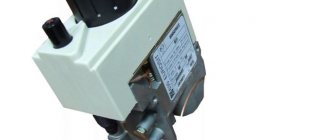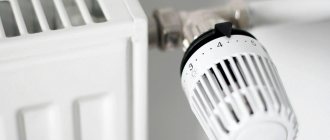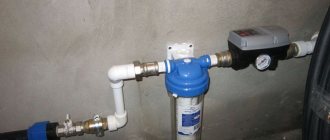A room thermostat today is simply an indispensable complementary module for a heating boiler. For an uninformed person, this is simply an expensive remote temperature controller that allows you to control the climate in the house directly from the living room.
In practice, a good and functional thermostat costing 3-5 thousand rubles, with proper operation, can greatly reduce operating costs for heating, maintain a more stable temperature, reduce the frequency of turning on and off a gas boiler, which will extend its life.
Models of room thermostats are universal and are suitable for all boilers (gas, solid fuel, liquid fuel, electric) that have the appropriate connectors for connecting it (see the instructions for the boiler).
What is a thermostat for a heating boiler?
This is what a modern electronic room thermostat looks like.
Why is it needed and how is it used
The main reason for choosing a room thermostat is savings, that is, a reduction in fuel consumption by up to 25-30%. This is achieved through the ability to program the boiler’s operation for a day or a week in advance. For example:
- You can reduce the temperature at night to 18-19°C - the most comfortable temperature for sleeping. Moreover, each reduced degree reduces fuel consumption by 2-5%.
- You can lower the temperature to 15-16°C for times when the owners are not at home, for example during working hours.
Also, savings are achieved even without a programming function: by controlling the operation of the boiler depending on the air temperature, and not the coolant temperature. This allows you to more accurately and stably, without the slightest jumps, maintain the set temperature, minimize the inertia of the heating system, and if you have a modulating burner, keep it on for as long as possible, but at minimum power - the most optimal mode of operation of the boiler both in terms of fuel consumption and conservation of the resource.
Everything, even the simplest mechanical room thermostats, come with an air temperature sensor by default. Many models also include a remote sensor for heated floors.
Of course, in addition to saving money, the thermostat also increases the operating comfort of the heating system. Depending on the functionality, using the thermostat you can organize weather-dependent control by connecting an external street sensor, control the boiler from a smartphone (via Wi-Fi) and receive notifications of operational failures via SMS (if there is a GSM module), simply fine-tune the operation boiler
Existing types
The settings specified on the thermostat always have priority for the boiler; its operating principle does not change (modulation of the burner flame is used, adjustment of the turbine rotation speed, etc.) despite the “dry contact” with the thermostat. The operating principle of a room thermostat depends on the type of temperature sensor it uses.
1. Mechanical thermostats
The simplest and most inexpensive models without any broad functionality. The principle of their operation is to use membrane sensors - heat-sensitive metals, liquids or gases, which are placed in a small sealed capsule. When heated, the substances expand and, upon reaching the set temperature, exert pressure on the relay membrane sufficient to close the contacts, after which the thermostat sends a signal to reduce the boiler power or turn it off completely.
Mechanical devices, as a rule, are limited only by a rotator for selecting temperature, have a noticeable error of up to 3-4°C, and only have a wired connection method.
2. Electromechanical
More accurate (but still not enough), more expensive, still limited in functionality thermostats.
The principle of operation is similar to the action of mechanical ones, but in this case, heat-sensitive metals are used, which, when heated, produce a micro-discharge or create resistance. Some models have a simple screen for displaying temperature and a smaller step for changing it - 0.5°C. However, this still poorly justifies their 30-40% higher price, given that there are more accurate and functional analogues.
3. Electronic
Modern, accurate, multifunctional and convenient thermostats. The kit often includes additional sensors for heated floors. The error of electronic models is no more than 0.5-0.7°C, most have the ability to be programmed, almost all devices are equipped with functions of protection against overheating and freezing, stopping the circulation pump and other safety systems.
The most expensive models have built-in Wi-Fi and GSM modules, save statistics, have a large number of automatic modes and a wireless connection to the boiler. Despite the highest cost, electronic room thermostats fully justify it and pay for themselves within a few months of proper use.
Thermostat for a heating boiler: temperature regulator or more?
There are several types of boilers. These are gas, solid fuel, and electric models. The material used to manufacture such equipment is cast iron or steel. Temperature control and adjustment is carried out using a special thermoelement. This equipment is a metal structure. As a result of thermal expansion, the position of the lever that moves the damper changes. To allow the combustion to grow, the damper is opened slightly. Newer designs include controllers that can regulate air flow.
Thermostatic draft regulator for solid fuel boiler
The most commonly used gas models are single-circuit and double-circuit. Some models have separate room thermostats for a gas boiler for a circuit with hot water supply and a heating circuit.
Electrical devices are distinguished by high efficiency and simple connections. In such designs there is protection against overheating and temperature control. Using a mechanical timer, various methods of temperature control are made. More often, the unit simply turns on/off when the temperature drops/exceeds. But it is also possible to set a specific switching time.
Electrical unit design
Helpful information! Mechanical devices have a round dial. To set the on time you need to turn the dial. Such devices are easy to adjust.
We achieve maximum stability and comfort
An additional feature of many electronic thermostats is the ability to organize weather-dependent control, when the boiler power is adjusted, including changes in the outside temperature. To do this, just connect a universal outdoor temperature sensor to the thermostat (2-2.5 thousand rubles).
External temperature sensor for Gira thermostat 130200.
It consists of a single structure: a sensor and a wire 2-6 m long. Therefore, it is enough just to fix the wire strands in the corresponding contacts of the thermostat, according to the instructions.
How to choose a room thermostat for a heating boiler
Wired or Wireless
Wired models are not limited in functionality, can be installed in any room (up to 20 meters from the boiler), are cheaper, but require a wired connection to the boiler. The wire itself is usually provided in the kit.
Wireless thermostats consist of a control panel with an air temperature sensor (essentially a regular thermostat) and a receiver that receives a signal from the remote control and transmits it to the boiler in a wired manner. Accordingly, the receiver is installed in the boiler room, and there may be more than one thermostat, for example, in several rooms. The advantages of wireless communication are obvious: there is no need to run wires throughout the house.
From the thermostat to the receiver, the signal is transmitted over a standard household appliance channel with a frequency of 433 or 868 MHz and does not affect any other household appliances or any other electronic devices in the house. Most models transmit signals over distances of up to 20 or 30 meters, taking into account walls, ceilings or partitions. It is worth considering that batteries are required to power a wireless thermostat, usually 2 standard AA batteries.
Temperature setting accuracy
Mechanical and electromechanical thermostats are quite cheap, but have a high error in the context of home heating - from 2 to 4°C. In this case, the temperature adjustment step is usually 1°C.
It is better to choose a more accurate electronic model with an error of 0.5-0.7°C and an adjustment step of 0.5°C. This is unlikely to have an impact on savings, but definitely on comfort. In addition, the main function for which the thermostat is so valued, the programmer, is available only in electronic models.
Ability to set the hysteresis value
Hysteresis (lag, delay) in the context of a heating system and thermostat is the difference between the temperature at which the boiler turns on and off with a uniform flow of coolant. That is, if the temperature on the thermostat is set to 22°C, and the hysteresis is 1°C, then when the air temperature reaches 22°C, the boiler will turn off and start when the temperature drops by 1°C, that is, at 21°C.
In mechanical models, the hysteresis is usually 1 or 2°C and cannot be changed. In electronic models with the ability to adjust it, you can set the value to 0.5°C or even 0.1°C. Accordingly, the lower the hysteresis, the more stable the temperature in the house.
Availability of a programmer
An example of a programmable thermostat with a temperature graph displayed on the main screen.
The programmer is an opportunity to set a boiler operation pattern for a time period from 8 hours to 7 days. Of course, manually lowering the temperature before leaving for work, leaving or going to bed is quite troublesome. Using the programmer, you can create one or several operating templates once and, depending on the temperature and hysteresis settings, save up to 30% of fuel each subsequent month.
This means that even when heating a small house with an area of 80-100 m2, a high-tech, expensive thermostat for 4-6 thousand rubles will pay for itself in 2-4 months of the heating season.
Availability of Wi-Fi or GSM module
Controllers with a Wi-Fi module can be connected to the home network and controlled using an application on a smartphone. A rather tangible advantage is the GSM module, with the help of which you can not only turn on the heating system in advance and heat the house even before arrival, but also control the operation of the system during a long departure: in case of any malfunctions, a corresponding notification will be sent to your phone.
Security systems
Protection against overheating or freezing of the heating system, protection against stopping the circulation pump, protection of the pump against souring in the summer (on once a day for 15 seconds) - all these functions seriously increase the safety of the heating system and are often found in medium and high-priced boilers segments. If such systems are not provided by the boiler automation, the issue can be resolved by choosing a thermostat with them.
How to choose a room thermostat for a gas boiler
Automation in the heating system allows you to more accurately control the temperature in heated rooms and save on fuel. By installing a thermostat for the heating boiler in the house, the owner of the cottage increases the efficiency of the boiler equipment by 20–30% and greatly simplifies its maintenance.
There are several types of thermostats, and each of them has its own installation location. You need to choose the device wisely.
How does a heating thermostat work?
A conventional heating system with water as a coolant consists of heating equipment or a connection point to a centralized network, internal wiring pipes and radiators. To regulate the volume of heat coming from it into the rooms, you have to either constantly monitor the boiler or regularly close/open the valves on the radiators.
At the same time, the inertia of such a system does not allow maintaining the desired temperature throughout the day at the set level. If you put more firewood into the stove or supply gas to the boiler, the coolant in the pipes will heat up more, and it will also release more heat through the radiators.
This is good at low temperatures outside. But with sudden warming outside, the heat in the house becomes unbearable. The fuel is already in the firebox, and the water has already heated up, there is no way to get rid of the heat. Plus the boiler continues to work. Without a thermostat in the system, you have to turn it off manually. You can, of course, open the windows for ventilation and let out the heat, but then the fuel bills for your home boiler room will definitely ruin you.
The conclusion suggests itself: a heating thermostat simplifies living and makes it as comfortable as possible.
A thermostat (temperature regulator) is a device for monitoring the temperature in a heated room and increasing/decreasing the heat supply to it
The thermostat for the heating system consists of:
temperature-sensitive sensor (element); tuning unit; control module; electromagnetic relay or mechanical valve.
In the simplest models there is no control unit. Everything happens due to pure mechanics and changes in the physical properties of the temperature-sensitive element. These thermostats do not require power supply. In terms of efficiency and accuracy of system adjustment, they are inferior to electronic devices, but they are non-volatile. If there are problems with the voltage in the network, they will definitely not stop working.
The operating principle of the thermostat is as follows:
Using the control unit, the desired temperature is set. When the required parameters are reached, the sensor is triggered, which leads to the boiler turning off or the shut-off valve in the heating pipes closing. After the air temperature in the room drops, the boiler equipment or heaters turn back on.
The electronic control module allows you to set not just one temperature indicator, but several for each time of day separately. Plus, if such a unit is available, it is possible to install an additional temperature sensor outside and link the functioning of the thermostat to the data from it.
Depending on the type of device, the thermostat is connected directly to the boiler to regulate its operation or at the inlet to the radiator to control the volume of coolant supply
The simplest thermostat is a shut-off valve with a temperature sensor, located on a pipe near the battery. When the desired temperature is reached, the valve closes and reduces the coolant current. And when the room air cools, it opens again, resulting in an increase in the volume of incoming heat.
More complex and advanced models require wireless sensors and control units. All communication between individual elements occurs through a radio channel. In this case, wires are not laid, which has a positive effect on the aesthetic side of placing such thermostats in the room.
Types of thermostats for boilers
The main difference between thermostats is different types of temperature-sensitive sensors. Some are installed on the heating pipe, others inside it, and others are mounted on the wall. Some are designed to measure air temperature, and the second - coolant.
The choice of thermostat model depends on:
boiler type; heating system wiring diagrams; availability of free space; required functionality.
Many modern boilers are pre-designed to connect thermostats to them. Moreover, the manufacturer of boiler equipment immediately writes down all the nuances of this installation in the technical data sheet.
If an electronic thermostat model is selected, then it is best to give preference to the most efficient one - the one recommended by the boiler developer
Ideally, the thermostat should regulate the operation of the heating device itself, that is, the supply of fuel to it. This is the most efficient connection scheme in terms of fuel economy. In this case, the energy carrier will be burned exactly as much as the heat required.
But such a thermostat can only be installed on a gas or electric heating unit. If the boiler is solid fuel, then a thermostat with a mechanical valve, which is mounted on the pipe, will help regulate the room temperature.
Regulators installed on batteries are designed to shut off the water supply if the temperature in the room or coolant is too high. In this case, the boiler stops working a little later, when its own temperature sensor inside is activated, preventing overheating of the equipment.
Group #1: mechanical
The operation of a mechanical temperature sensor is based on a change in the characteristics of a material when its temperature changes. This is an easy-to-use, budget-friendly, fairly effective and completely power-independent option. It is designed for installation on pipes of a water heating system to regulate the flow of coolant.
A classic example of a mechanical thermostat is a device with a needle valve (constipation) and a thermal bellows head
The following substances are used in mechanical thermostats as a substance that responds to temperature changes:
gas; liquid.
When the liquid is heated, the gases expand, which leads to their pressure on the shut-off valve stem. When the temperature drops, they compress, the constipation is returned by a spring, and the heated water again flows through the pipes into the heating radiators.
Such thermostats are characterized by poor sensitivity and large adjustment errors. They only work when the temperature rises by 2 degrees or more. Plus, over time, the bellows filler loses its characteristics, the numbers on the knob for setting the required temperature parameters and the actual degrees begin to diverge.
These thermostats are quite large in size. The vast majority of them are designed to measure the temperature of the water in the batteries, and not the air in the room. It is often difficult to precisely adjust them the way the home owner wants.
Group #2: electromechanical
These thermostats operate on principles similar to their purely mechanical counterparts. Only a metal plate is used here as a heat-sensitive element. When heated, it bends and closes the contact, and when cooled, it returns to its original position and opens the circuit. And through this circuit a signal is sent to the burner control unit.
The electromechanical thermostat requires power supply; it controls the valves or burners in the boiler that regulate the flow of coolant using electrical signals.
We recommend: How to choose an electric fireplace for a house, apartment, with the effect of a living fire - we analyze it carefully
Another option for an electromechanical thermostat is a device with a sensor in the form of two plates made of different metals. In this case, the heat-sensitive element is installed directly into the firebox of the solid fuel boiler.
At high temperatures, a potential difference occurs between the plates, affecting the electromagnetic relay. The contacts in the latter alternately open and close. As a result, air injection into the combustion chamber is turned on/off.
Group #3: electronic
This type of thermostats for hot water boilers belongs to the energy-dependent category. Such devices have a remote temperature sensor that monitors the room temperature and a full-fledged control unit with a display. For electric boilers, such thermostats are a mandatory addition. Without them, electric heaters will work without stopping, heating the air or coolant too much.
In the vast majority of cases, boilers and boilers operating on electricity are equipped with thermostats at the factory.
An electronic thermostat has two main elements:
Temperature sensor. Microcontroller.
The first measures the temperature, and the second controls it and issues signals to increase/decrease the supply of thermal energy to the room. The sensor can send an analog or digital signal to the controller. In the first case, the thermostat’s capabilities are similar to its mechanical counterpart, only it greatly exceeds it in the accuracy of temperature measurements.
Digital thermostats are the pinnacle of development of these devices. They allow you to regulate heat supply according to a preset algorithm. Plus, you can connect many more sensors to them, located both in rooms and outside.
Many electronic thermostats have remote control capabilities via infrared or cellular. This allows you to regulate the room temperature not only using the remote control in the room, but also from any point outside it. For example, while still leaving work, you can send a signal to heat the room air to comfortable parameters, and when you arrive the house will delight you with comfort and warmth.
Connection diagrams
All methods of connecting a thermostat to a heating system are divided into three connection options:
Directly to the boiler. To the circulation pump. On the pipe supplying coolant to the radiator.
The first two schemes eliminate the deterioration in the throughput of the heating pipeline. No additional locks are placed in it, and the hydraulic resistance of the entire system does not change. The thermostat here only controls the operation of the pump or boiler; it “does not come into contact” with water.
When installing a thermostat on a battery or a common pipe with several radiators, the hydraulic resistance, on the contrary, increases. Even when fully open, the thermostat valve slightly slows down the flow of coolant. Ideally, the boiler piping project should be carried out immediately, taking into account all thermostatic and other devices.
Thermostats should only be installed into existing heating pipelines as a last resort; maximum efficiency from their use can only be achieved if they are included in the system at the design stage
If the water heating system in the house is made of a single pipe, then it is better to immediately abandon the third option. When the temperature sensor is triggered, the valve will immediately shut off the entire radiator line in several rooms, and then you can immediately forget about comfort in rooms far from the boiler.
The thermostat should be connected to the radiator input via a bypass. So, when triggered, it will redirect the coolant flow bypassing the battery. In this case, the water will return uncooled back to the boiler. The latter will stop heating it, thereby reducing the consumption of gas fuel or electricity.
When installing a thermostat air temperature sensor, you must adhere to certain rules, otherwise, under the influence of neighboring devices or objects, it will trigger falsely.
The temperature sensor must be mounted:
in a place where there is no direct sunlight; away from cold bridges, drafts and rising heat flows from radiators; so that it is not covered by decorative screens or curtains; at a height from the floor within 1.2–1.5 meters.
If the sensor is installed incorrectly, the thermostat will produce false signals. This can lead to overheating not only of the air in the room, but also of the coolant in the system. And in the second case, it won’t be long before there are problems with the boiler.
Conclusions and useful video on the topic
There should not be any particular difficulties with installing the thermostat. You just need to choose it correctly for a specific heating system. And the selected video materials will definitely help you with this.
Connecting a room thermostat to a gas boiler in all its nuances:
Wall thermostat review:
Technology for incorporating a contact thermostat into a system with a circulation pump:
An addition to a heating boiler in the form of a thermostat is a great way to save money on heating your home, increase living comfort and reduce wear and tear on equipment that heats the coolant. The money spent on thermostats pays off in one winter season. In this case, you can choose either a simple mechanical option with manual control or a more advanced device with a programmer.
Source: sovet-ingenera.com
| Share on social networks: | Rate this article: (No votes) Loading… |
The best known manufacturers and models: characteristics and prices
BAXI KHG
A well-known simple mechanical thermostat without additional functions or settings. Among mechanical analogues, it is distinguished by Italian build quality and reliability, standard hysteresis of 1°C, and minimalistic, pleasant design. The disadvantages are standard for all mechanical devices - high error, temperature steps of 1°C rather than 0.5°C, constant hysteresis.
Cost: 1,350-1,500 rubles.
TEPLOCOM TS-Prog-2AA/8A
Wired programmable electronic thermostat. It is distinguished by the presence of almost all the functions available today at a low price, essentially the best choice in terms of price-quality ratio.
It has a good contrast display, the ability to set minimum and maximum temperatures, pump protection mode, protection against overheating and freezing, indication of system malfunction, setting hysteresis, programming temperature schedules for 7 days, etc.
The disadvantages are the wired connection and, despite this, power from 2 AA batteries, they are enough for 1-1.5 years of operation.
Cost: 3,300-3,400 rubles.
TEPLOCOM TS-Prog-2AA/3A-RF
The programmable thermostat is absolutely similar to the previous model, but with a wireless connection at a frequency of 868 MHz, which means an increase in the reception range up to 100 meters. The receiver is connected to the boiler via a wired connection. The disadvantage of this model is its rather high price, since wired analogs for this price can have built-in Wi-Fi and GSM modules, and the kit includes sensors for heated floors.
Cost: 5,400-6,500 rubles.
TEPLOLUX MCS-350
One of the best room thermostats for a heating boiler. It has almost all modern monitoring and protective functions, 24/7 programming mode, and detailed consumption statistics. It is distinguished by the presence of a touch LCD display with automatic locking, the presence of a Wi-Fi module that allows you to control the system from a smartphone, and an additional remote temperature sensor included (up to 32 sensors can be connected in total).
Thanks to Wi-Fi, the thermostat can be installed in any inconspicuous place and controlled from a smartphone, but even with an open installation, it will harmoniously fit into almost any interior.
Cost: 4,590-6,000 rubles.
Prices: summary table
| Manufacturer and model | Peculiarities | Cost, rub. | Our rating, 0-5 points |
| BAXI KHG | Mechanical, inexpensive and reliable | 1 350 | 3,9 |
| TEPLOCOM TS-Prog-2AA/8A | Programmable, wired, functional, best in price-quality ratio | 3 300 | 4,5 |
| TEPLOCOM TS-Prog-2AA/3A-RF | Programmable, wireless, functional, expensive | 5 500 | 4,3 |
| TEPLOLUX MCS-350 | Programmable, wired, functional, with Wi-Fi module and touch display, with additional. sensor, modern stylish design | 5 100 | 4,9 |
Connecting the thermostat to the boiler: instructions
To obtain accurate measurement results, it is important to choose the right installation location:
- Installation near windows, entrance doors, ventilation ducts, climate control equipment and other objects that can affect the air temperature at the installation site is not recommended;
- It is not recommended to install it too high, near the ceiling, or too low to the floor, since heated air masses are concentrated near the ceiling, and in the absence of a heated floor, the temperature in the lower plane of the room is noticeably lower. The optimal installation height is 1.5 meters from the floor level;
- Installation near moving objects or objects that create mechanical shocks (doors, furniture touching the wall) is not recommended;
Also note that for loads above 10 A, the device is not connected directly, but through a modular contactor.
The connection and installation algorithm is always specified in the instructions for the device. For example, let's look at how to install a mechanical Cewal RQ-10:
| Photo | Process description |
| Remove the temperature control rotator | |
| Having removed the front panel, unscrew the corresponding screws | |
| We mount the structure on the wall through the appropriate holes specified in the instructions. | |
| According to the diagram from the instructions, connect the contacts. For the Cewal RQ-10 model, this diagram is shown in the photo. | |
| Additionally. There may be a jumper between the “TA” contacts of the board of some boilers; it must be replaced with a two-core insulated cable with a conductor cross-section of 0.5-0.75 mm2. |
Most modern thermostats are powered by AA batteries, but if power from the mains is required, its organization diagram looks like this:
All modern models of thermostats are supplied with instructions with a detailed, schematic description of the installation, connection and configuration algorithm. However, this requires basic electrical skills in any case.
General connection principles
The diagram for connecting the thermostat directly to the heating equipment is always indicated in the technical documentation attached to the gas boiler. Modern equipment from any manufacturer is equipped with connection points for a temperature control device.
When using a wireless thermostat, the measuring unit is placed in the living room. It is recommended to install it in the coldest room or where people are most often present.
You should not install a thermostat unit in a kitchen or boiler room where the temperature regime is unstable.
Basic installation rules include:
- the height of the location should not exceed 1.5 meters from the floor level;
- do not attach to a cold or external wall of the room;
- prevent exposure to direct sunlight;
- exclude installation in close proximity to gas stoves, air conditioners and frequently opened windows.
Installing the Thermostat
The thermostat should be located in an easily accessible place for the most convenient operation and subsequent maintenance.










